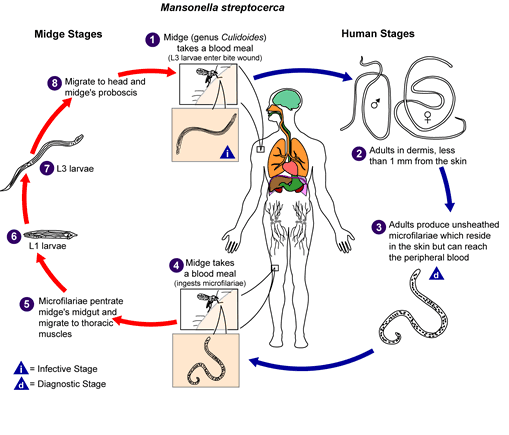Mansonella Streptocerca on:
[Wikipedia]
[Google]
[Amazon]
''Mansonella streptocerca'', (formerly ''Diptalonema streptocerca''), is a
 The contraction of an ''M. streptocerca'' infection can be better understood through an understanding of its life cycle. The life cycle involves two stages: one involving a midge (genus ''
The contraction of an ''M. streptocerca'' infection can be better understood through an understanding of its life cycle. The life cycle involves two stages: one involving a midge (genus ''
filaria
''Filaria'' is a genus of nematodes belonging to the family Filariidae.
The genus has cosmopolitan distribution.
Species:
*'' Filaria acutiuscula''
*'' Filaria bufonis''
*'' Filaria loliginis''
*'' Filaria martis''
*'' Filaria piscium'' ...
l (arthropod
Arthropods (, (gen. ποδός)) are invertebrate animals with an exoskeleton, a Segmentation (biology), segmented body, and paired jointed appendages. Arthropods form the phylum Arthropoda. They are distinguished by their jointed limbs and Arth ...
-borne) nematode
The nematodes ( or grc-gre, Νηματώδη; la, Nematoda) or roundworms constitute the phylum Nematoda (also called Nemathelminthes), with plant-Parasitism, parasitic nematodes also known as eelworms. They are a diverse animal phylum inhab ...
(roundworm) causing the disease streptocerciasis. It is a common parasite in the skin of humans in the rain forests of Africa, where it is thought to be a parasite of chimpanzees, as well.
''Mansonella streptocerca'' is one of three filarial nematodes that cause subcutaneous filariasis in humans. The other two filarial nematodes are ''Loa loa
''Loa loa'' is a filarial (arthropod-borne) nematode (roundworm) that causes ''Loa loa'' filariasis. ''Loa loa'' actually means "worm worm", but is commonly known as the "eye worm", as it localizes to the conjunctiva of the eye. ''Loa loa'' is ...
'' (the African eye worm), and ''Onchocerca volvulus
''Onchocerca volvulus'' is a filarial (arthropod-borne) nematode (roundworm) that causes onchocerciasis (river blindness), and is the second-leading cause of blindness due to infection worldwide after trachoma. It is one of the 20 neglected trop ...
'' (river blindness).
The worm is distributed across West and Central Africa.
Life cycle
 The contraction of an ''M. streptocerca'' infection can be better understood through an understanding of its life cycle. The life cycle involves two stages: one involving a midge (genus ''
The contraction of an ''M. streptocerca'' infection can be better understood through an understanding of its life cycle. The life cycle involves two stages: one involving a midge (genus ''Culicoides
''Culicoides'' is a genus of biting midges in the family Ceratopogonidae. There are over 1000 species in the genus,Connelly, C. RBiting midges: ''Culicoides'' spp.Featured Creatures, Entomology and Nematology Department, University of Florida IF ...
'') and another involving a human host. First, a midge ingests a blood meal from a human host. This allows third-stage filarial larvae to enter the bite wound. Once inside the dermis, the larvae develop into adults, usually less than 1 mm from the surface of the skin. In terms of size, the females can reach 27 mm in length, whereas the males can be around 50 μm in diameter. These adults then produce nonperiodic microfiliariae, which habitate in the skin, but can also travel to the peripheral blood. These microfilariae are then passed onto the midge when the insect ingests a blood meal. Following the blood meal, microfilariae travel to the midge’s midgut through the hemocoel to the thoracic muscles. In the thoracic muscles, the microfiliariae develop into first-stage larvae, followed up by third-stage development. In this latter stage, the larvae travel to the midge’s proboscis, where it can subsequently infect another human host upon another blood meal ingestion.
Prevalence
M. streptocerca has reportedly been found in West and Central Africa including Western Uganda, the Uganda-Zaire border, and the Bundibugyo district.Morphology
The adult form of ''M''. ''streptocerca'' was discovered by Dr. Wayne M Meyers while working as a medical missionary in Africa. M. streptocerca adults have a unique posterior end that is bent, resembling the shape of a shepherd’s crook. This feature makes it possible for laboratory workers to distinguish M. streptocerca from other species of roundworms.Diagnosis
The infection of these roundworms typically causes no symptoms but may sometimes cause a mild dermatitis of the thorax and shoulders. M. streptocerca infections fortunately do not cause any nodules, skin disease, or ocular infections like that of Onchocerca volvulus. Due to the absence of nodules, differentiating between M. streptocerca and O. volvulvus infections are easier to diagnose.Treatment
Treatment of streptocerciasis includes the use of diethylcarbamazine (DEC) which is reportedly effective against the microfilarial and adult stage M. streptocerca, but not proven as a method of treatment. A common drug used to treat roundworms, Ivermectin, is not proven to serve as a treatment for streptocerciasis although it is shown that ivermectin should not be used as a mass treatment in endemic areas where only M. streptocerca is found. This is because the side effects of the drug commonly outweigh the consequences of the infection.Prevention
Take preventative measures by using DEET or other insect repellents to ward off midges when traveling into endemic areas.See also
See Mansonelliasis. *List of parasites (human)
Endoparasites Protozoan organisms
Helminths (worms)
Helminth organisms (also called helminths or intestinal worms) include:
Tapeworms
Flukes
Roundworms
Other organisms
Ectoparasites
References
{{Portal bar, Bio ...
References
External links
{{DEFAULTSORT:Mansonella Streptocerca Spirurida Parasitic nematodes of humans